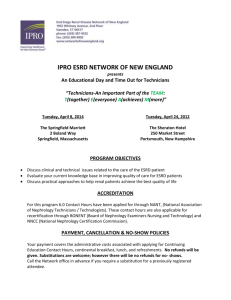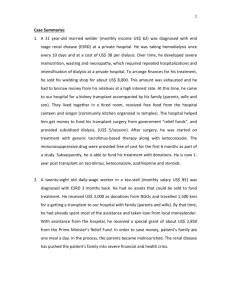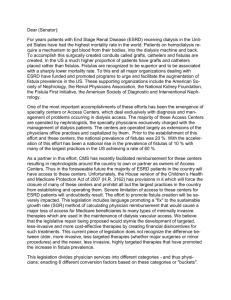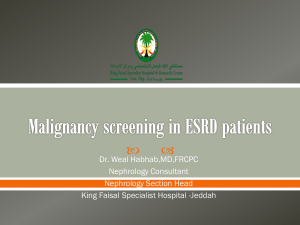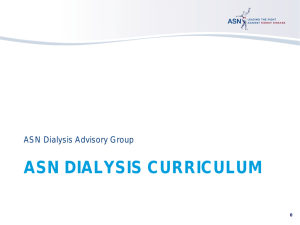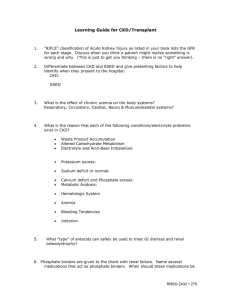Slides (PowerPoint)
advertisement
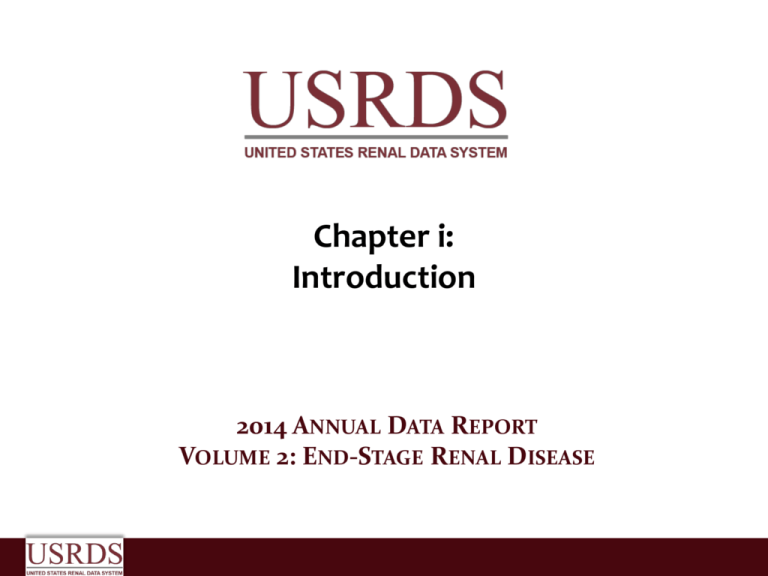
Chapter i: Introduction 2014 ANNUAL DATA REPORT VOLUME 2: END-STAGE RENAL DISEASE vol 2 Table i.1 Summary statistics on reported ESRD therapy in the United States, by age, race, ethnicity, sex, & primary diagnosi s, 2012 Incidence a Count 0-19 e 20-44 45-64 65-74 75+ Unknown age White Black/African American Native American Asian Other Unknown Hispanic Non-Hispanic Male Female Unknown gender 1,163 13,162 45,069 27,933 27,486 . 76,089 31,398 1,273 5,840 50 163 17,024 97,789 65,842 48,971 . December 31 point prevalence Adj. rateb % 1.0 11.5 39.3 24.3 23.9 . 66.3 27.3 1.1 5.1 0.0 0.1 14.8 85.2 57.3 42.7 . 13.1 122.2 570.2 1,270.1 1,618.4 . 279.2 908.0 411.5 378.9 501.3 340.5 446.0 278.0 . Count 7,545 101,994 283,021 140,238 104,107 . 383,534 200,797 8,154 35,878 5,860 2,682 106,308 530,597 363,497 273,312 96 % 1.2 16.0 44.4 22.0 16.3 . 60.2 31.5 1.3 5.6 0.9 0.4 16.7 83.3 57.1 42.9 0.0 Adj. rate b 83.1 938.0 3,550.1 6,301.8 6,261.1 . 1,431.8 5,670.5 2,599.5 2,271.8 2,931.9 1,857.8 2,396.7 1,558.4 . Dialysis c 2,060 59,045 188,571 106,101 94,825 . 252,053 164,211 6,310 25,230 2,515 283 79,352 371,250 252,526 198,006 70 Kidney transplants Tx c % 0.5 13.1 41.8 23.5 21.0 . 55.9 36.4 1.4 5.6 0.6 0.1 17.6 82.4 56.0 43.9 0.0 5,485 42,949 94,450 34,137 9,282 . 131,481 36,586 1,844 10,648 3,345 2,399 26,956 159,347 110,971 75,306 26 % 2.9 23.1 50.7 18.3 5.0 . 70.6 19.6 1.0 5.7 1.8 1.3 14.5 85.5 59.6 40.4 0.0 Deceased donor 549 2,918 5,851 1,928 247 42 6,892 3,547 135 809 75 77 1,956 9,579 6,973 4,520 42 Living ESRD deaths d donor 350 84 1,925 3,929 2,549 26,555 696 24,563 76 33,507 21 4,450 59,868 718 23,868 41 1,012 352 3,400 * 490 48 . 804 11,433 4,813 77,205 3,483 49,939 2,113 38,696 21 * Data Source: Reference tables: A, B, D, E &H. a Incident counts: include all known ESRD patients, regardless of any incomplete data on patient characteristics and of U.S. residency status; b Includes only residents of the 50 states and Washington D.C. Rates are adjusted for age, race, and/or sex using the estimated 2011 U.S. resident population as the standard population. All rates are per million population. Rates by age are adjusted for race and sex. Rates by sex are adjusted for race and age. Rates by race are adjusted for age and sex. Rates by disease group and total adjusted rates are adjusted for age, sex, and race. Adjusted rates do not include patients with other or unknown race. c Patients are classified as receiving dialysis or having a functioning transplant. Those whose treatment modality on December 31 is unknown are assumed to be receiving dialysis. Includes all Medicare and non-Medicare ESRD patients, and patients in the U.S. territories and foreign countries. d Deaths are not counted for patients whose age is unknown. e Age is computed at the start of therapy for incidence, on December 31 for point prevalence, at the time of transplant for transplants, and on the date of death for death. . Zero values in this cell. Abbreviations: Adj., adjusted; ESRD, end-stage renal disease; Tx, transplant. Vol 2, ESRD, Ch i 2 vol 2 Table i.1 Summary statistics on reported ESRD therapy in the United States, by age, race, ethnicity, sex, & primary diagnosi s, 2012 (continued) Incidence a Count Diabetes Hypertension Glomerulonephritis Cystic kidney disease Urologic disease Other known cause Unknown cause Missing cause All Unadjusted rate g 50,534 32,610 9,115 2,530 538 12,281 3,506 3,699 114,813 % 44.0 28.4 7.9 2.2 0.5 10.7 3.1 3.2 100.0 Adj. rateb 154.3 101.1 28.3 7.9 1.6 38.2 10.8 10.6 353.2 358.6 Count 239,837 159,049 106,012 29,881 7,447 59,714 25,977 8,988 636,905 % 37.7 25.0 16.6 4.7 1.2 9.4 4.1 1.4 100.0 December 31 point prevalence Adj. Dialysis c % rate b 731.0 197,079 43.7 489.4 129,092 28.6 325.8 52,841 11.7 92.4 11,526 2.6 22.9 3,576 0.8 184.7 37,458 8.3 78.2 15,883 3.5 18.1 3,147 0.7 1,942.9 450602 f 100.0 1,968.2 Tx c 42,758 29,957 53,171 18,355 3,871 22,256 10,094 5,841 186,303 % 23.0 16.1 28.5 9.9 2.1 11.9 5.4 3.1 100.0 Kidney transplants Deceased Living ESRD donor donor deaths d 3,355 1,081 40,795 2,505 833 24,975 2,549 1,679 6,828 832 620 1,548 133 91 589 1,356 783 9,935 423 216 3,101 382 314 867 11,535 5,617 88,638 Total transplants 17,330 h Data Source: Reference tables: A, B, D, E &H. a Incident counts: include all known ESRD patients, regardless of any incomplete data on patient characteristics and of U.S. residency status; b Includes only residents of the 50 states and Washington D.C. Rates are adjusted for age, race, and/or sex using the estimated 2011 U.S. resident population as the standard population. All rates are per million population. Rates by age are adjusted for race and sex. Rates by sex are adjusted for race and age. Rates by race are adjusted for age and sex. Rates by disease group and total adjusted rates are adjusted for age, sex, and race. Adjusted rates do not include patients with other or unknown race. c Patients are classified as receiving dialysis or having a functioning transplant. Those whose treatment modality on December 31 is unknown are assumed to be receiving dialysis. Includes all Medicare and non-Medicare ESRD patients, and patients in the U.S. territories and foreign countries. d Deaths are not counted for patients whose age is unknown. f Includes patients whose modality is unknown. g Unadjusted total rates include all ESRD patients in the 50 states and Washington D.C. h Total transplants as known to the USRDS * Values for cells with ten or fewer patients are suppressed. . Zero values in this cell. Abbreviations: Adj., adjusted; ESRD, end-stage renal disease; Tx, transplant. Vol 2, ESRD, Ch i 3 vol 2 Figure i.1 Counts of new & returning dialysis patients, 1991 –2012 (a) New patients (b) Patients restarting dialysis Data Source: CMS Form 2744, Annual Facility Survey. Patients restarting dialysis (Panel B) are those who had temporarily recovered kidney function, had discontinued dialysis or had been lost to follow-up but restarted routine dialysis during the survey period. Vol 2, ESRD, Ch i 4 vol 2 Figure i.1 Counts of new & returning dialysis patients, 1991 –2012 (continued) (c) Patients returning from transplant (d) Total patients starting /restarting Data Source: CMS Form 2744, Annual Facility Survey Vol 2, ESRD, Ch i 5 vol 2 Table i.2 ESRD-certified patients on the waiting list for kidney and kidney/pancreas transplants New listings in 2012 N (as of 12/31/2012) Median time on list (years) a 0-17 633 564 0.30 18-44 8,195 20,547 3.19 45-64 15,336 45,159 3.55 65-74 4,271 14,088 3.76 432 . 1,623 . 4.98 . Male 17,750 49,230 3.21 Female 11,117 32,751 3.53 White 17,537 44,248 2.61 African American 8,895 29,987 4.14 Native American 364 996 4.49 Asian 1,843 6,006 5.21 Other 228 744 4.59 75+ Unknown Unknown Hispanic Non-Hispanic . . . 5,413 16,080 4.49 23,454 65,901 3.15 Data source: Reference Table E. a patients listed for a kidney-alone transplant during 2007.* cells with ten or fewer patients are suppressed. .zero patients in this cell. Abbreviations: ESRD, end-stage renal disease. Vol 2, ESRD, Ch i 6 vol 2 Table i.2 ESRD-certified patients on the waiting list for kidney and kidney/pancreas transplants (continued) New listings in 2012 Diabetes Hypertension Glomerulonephritis Cystic kidney disease Urologic disease Other known cause Unknown cause Missing cause A B AB O PRA <10% 10% or greater Unknown Total N (as of 12/31/2012) Median time on list (years) a 4.47 3.56 2.46 10,323 6,385 6,061 28,240 19,764 18,331 1,515 4,582 1.92 273 2,964 877 469 9,317 4,224 1,127 14,199 26,529 2,338 . 28,867 850 7,026 2,729 459 22,964 13,375 2,267 43,375 67,518 14,394 69 81,981 2.47 1.33 2.36 . 2.23 4.20 1.36 4.18 3.04 4.33 . 3.31 Data source: Reference Table E. a patients listed for a kidney-alone transplant during 2007.* cells with ten or fewer patients are suppressed. . zero patients in this cell. Abbreviations: A, blood group A; AB, blood group AB, B, Blood group B; ESRD, end-stage renal disease; O, blood group O; PRA, panel reactive antibody. Vol 2, ESRD, Ch i 7 vol 2 Figure i.2 Trends in the number of incident cases of ESRD, in thousands, by modality, in the U.S. population, 1980-2012 Data Source: Reference table D1. Abbreviations: ESRD, end-stage renal disease. This graphic is also presented as Figure 1.1. Vol 2, ESRD, Ch i 8 vol 2 Figure i.3 Trends in the number of prevalent cases of ESRD, in thousands, by modality, in the U.S. population, 1980-2012 Data Source: Reference table D.1. Abbreviations: ESRD, end-stage renal disease. This graphic is also presented as Figure 1.10. Vol 2, ESRD, Ch i 9 vol 2 Figure i.4 Trend in the number of prevalent ESRD patients using home dialysis, in thousands, by type of therapy, in the U.S. population, 1980-2012 Data Source: Reference table: D.1. December 31 prevalent ESRD patients; peritoneal dialysis consists of CAPD & CCPD only. Abbreviations: CAPD, continuous ambulatory peritoneal dialysis; CCPD, continuous cycler peritoneal dialysis; ESRD, end-stage renal disease. This graphic is also presented as Figure 1.18. Vol 2, ESRD, Ch i 10 vol 2 Figure i.5 VA use during the first year of HD by time since initiation of ESRD treatment, among patients new to HD in 2012, from the ESRD Medical Evidence 2728 Form and CROWNWeb data Data Source: Special analyses, USRDS ESRD Database and CROWNWeb. ESRD patients initiating HD in 2012. Abbreviations: ESRD, endstage renal disease; HD, hemodialysis; VA, vascular access. This graphic is also presented as Figure 3.15. Vol 2, ESRD, Ch i 11 vol 2 Figure i.6 Mean monthly Hgb level and mean weekly EPO dose (monthly average, expressed in units/week) in adult HD patients on dialysis ≥90 days, from Medicare claims: time trend from 1995 -2012 Data Source: Data Source: Special analyses, USRDS ESRD Database. Panel a: Mean monthly Hgb level among ESA-treated HD patients within a given month (1995 through 2012) or all HD patients irrespective of ESA use (April to December 2012 only) if, within the given month, the patient had an Hgb claim, was on dialysis ≥90 days, and was ≥18 years old at the start of the month. Mean monthly EPO (epoetin alfa) dose among HD patients within a given month who had an EPO claim, were on dialysis ≥90 days, and were ≥18 years old at the start of the month. EPO dose is expressed as mean EPO units per week averaged over all EPO claims within a given month. Panel b: Monthly IV iron use among HD patients on dialysis ≥90 days and ≥18 years old at the start of the given month. Abbreviations: EPO, erythropoietin; ESA, erythropoiesisstimulating agents; HD, hemodialysis; Hgb, hemoglobin; IV, intravenous. This graphic is adapted from Figure 3.2. Vol 2, ESRD, Ch i 12 vol 2 Figure i.7 Trends in adjusted all-cause & cause-specific hospitalization rates, by modality (a) All ESRD (b) Hemodialysis Data Source: Reference tables: G.1, G.3, G.4, G.5, and special analyses, USRDS ESRD Database. Period prevalent ESRD patients; adjusted for age, sex, race, & primary diagnosis; ref: ESRD patients, 2010. Percent changes from 1993 for the year 2012 are shown in parentheses. Abbreviations: ESRD, end-stage renal disease. This graphic is also presented as Figure 4.1. Vol 2, ESRD, Ch i 13 vol 2 Figure i.7 Trends in adjusted all-cause & cause-specific hospitalization rates, by modality (continued) (c) Peritoneal dialysis (d) Transplant Data Source: Reference tables: G.1, G.3, G.4, G.5, and special analyses, USRDS ESRD Database. Period prevalent ESRD patients; adjusted for age, sex, race, & primary diagnosis; ref: ESRD patients, 2010. Percent changes from 1993 for the year 2012 are shown in parentheses. Abbreviations: ESRD, end-stage renal disease. This graphic is also presented as Figure 4.1. Vol 2, ESRD, Ch i 14 vol 2 Figure i.8 Rehospitalization or death within 30 days from live hospital discharge, by age, 2012 Data Source: Special analyses, USRDS ESRD Database. Period prevalent hemodialysis patients, all ages, 2012; unadjusted. Includes live hospital discharges from January 1 to December 1, 2012. Cause-specific hospitalizations are defined by principal ICD-9-CM codes. See Vol. 2, ESRD Analytical Methods for principal ICD-9-CM diagnosis codes included in each cause of hospitalization category. Abbreviations: ESRD, end-stage renal disease; rehosp, rehospitalization. This graphic is also presented as Figure 4.3. Vol 2, ESRD, Ch i 15 vol 2 Figure i.9 Adjusted all-cause mortality rates, overall and by modality Data Source: Reference Tables H.2, H.8, H.9, and H.10, and special analyses, USRDS ESRD Database. Adjusted for age, sex, race, and primary diagnosis. Ref: 2011 patients. Abbreviations: HD, hemodialysis; PD, peritoneal dialysis. This graphic is also presented as Figure 5.1. Vol 2, ESRD, Ch i 16 vol 2 Figure i.10 Adjusted all-cause mortality in the first year of hemodialysis, by year of initiation of dialysis Data Source: Special analyses, USRDS ESRD Database. Adjusted (age, race, sex, ethnicity, and primary diagnosis) all-cause & causespecific mortality in the first year of hemodialysis. Ref: incident hemodialysis patients, 2011. This graphic is also adapted from Figure 5.3. Vol 2, ESRD, Ch i 17 vol 2 Figure i.11 Adjusted all-cause mortality in the ESRD & general populations, by age, 2012 Data Source: Special analyses, USRDS ESRD Database and Medicare 5 Percent Sample. Adjusted for sex and race. Medicare data limited to patients with at least one month of Medicare eligibility in 2012. Ref: Medicare patients, 2012. Abbreviation: ESRD, end-stage renal disease. This graphic is also presented as Figure 5.4. Vol 2, ESRD, Ch i 18 vol 2 Figure i.12 Trends in transplantation: unadjusted rates, waiting list counts, waiting time, counts of transplants per year. (a) Percent of dialysis patients wait-listed and unadjusted and transplant rates (b) Counts of total transplants Data Source: Reference Tables E4, E9; E2, E3; E8, E8(2), E8(3); D9. Percent of dialysis patients on the kidney waiting list is for all dialysis patients. Unadjusted transplant rates are for all dialysis patients. Waiting list counts include all candidates listed for a kidney transplant on December 31 of each year. Waiting time is calculated for all recipients enrolled on the waiting list in a given year. Functioning transplant is the annual status on December 31 of each year of all patients who received a kidney transplant, regardless of transplant date. This graphic is adapted from Figure 6.1. Vol 2, ESRD, Ch i 19 vol 2 Figure i.13 Outcomes: deceased donor transplants at one year Data Source: Reference Tables F2, F14, I26; F5, F17, I29; F6, F18, I30. Outcomes among recipients of a first-time deceased donor kidney transplant; unadjusted. This graphic is adapted from Figure 6.8. Vol 2, ESRD, Ch i 20 vol 2 Figure i.14 Outcomes: living donor transplants at one year Data Source: Reference Tables F8, F20, I32; F11, F23, I35; F12, F24, I36. Outcomes among recipients of a first-time live donor kidney transplant; unadjusted. This graphic is adapted from Figure 6.9. Vol 2, ESRD, Ch i 21 vol 2 Figure i.15 Incident & December 31 point prevalent ESRD patients (aged 0 –19 years) (a) Incidence of ESRD in children (aged 0-19 years) (b) Prevalence of ESRD in children (aged 0-19 years) Data Source: Reference tables D3-D5, D7-D9, and special analyses, USRDS ESRD Database. Peritoneal dialysis consists of continuous ambulatory peritoneal dialysis and continuous cycling peritoneal dialysis. Abbreviations: ESRD, end-stage renal disease; HD, hemodialysis; PD, peritoneal dialysis; Tx, transplant. This graphic is also presented as Figure 7.1. Vol 2, ESRD, Ch i 22 vol 2 Figure i.16 Adjusted 5 year survival in pediatric ESRD patients from day 1 by age (aged 0 -19 years), 2003-2007 Data Source: Special analyses, USRDS ESRD Database. Incident dialysis and transplant patients defined at the onset of dialysis or the day of transplant without the 60-day rule; followed to December 31, 2012. Adjusted for age, sex, race, Hispanic ethnicity, and primary diagnosis. Ref: incident ESRD patients age 0-19, 2010-2011. Abbreviations: HD, hemodialysis; PD, peritoneal dialysis, Tx,transplant. This graphic is also presented as Figure 7.11. Vol 2, ESRD, Ch i 23 vol 2 Figure i.17 Dialysis units & patient counts, by unit affiliation, 2010 –2012 (a) Dialysis units Data source: Special analyses, USRDS ESRD Database. Abbreviations: DCI, Dialysis Clinic, Inc.; FMC, Fresenius; Hosp-based, hospital-based dialysis centers; Indep, independent dialysis providers; SDO, small dialysis organizations. This graphic is also presented as Figure 8.1. Vol 2, ESRD, Ch i 24 vol 2 Figure i.17 Dialysis units & patient counts, by unit affiliation, 2010 –2012 (continued) (b) Patient counts Data source: Special analyses, USRDS ESRD Database. Abbreviations: DCI, Dialysis Clinic, Inc.; FMC, Fresenius; Hosp-based, hospital-based dialysis centers; Indep, independent dialysis providers; SDO, small dialysis organizations. This graphic is also presented as Figure 8.1. Vol 2, ESRD, Ch i 25 vol 2 Figure i.18 Annual percent change in Medicare ESRD spending Data Source: USRDS ESRD Database. Total Medicare ESRD costs from claims data; includes all Medicare as primary payer claims as well as amounts paid by Medicare as secondary payer. Abbreviations: ESRD, end-stage renal disease. This graphic is also presented as Figure 9.4. Vol 2, ESRD, Ch i 26 vol 2 Figure i.19 Costs of the Medicare & ESRD programs (excluding Part D) Data Source: USRDS ESRD Database. Total Medicare expenditures obtained from http://CMS.gov. Abbreviations: ESRD, end-stage renal disease. This graphic is also presented as Figure 9.2. Vol 2, ESRD, Ch i 27 vol 2 Figure i.20 Incidence rate of ESRD, per million population, by country, in 2012 Data source: Special analyses, USRDS ESRD Database. Data presented only for countries from which relevant information was available. All rates are unadjusted. ^UK: England, Wales, Northern Ireland (Scotland data reported separately). Japan and Taiwan are dialysis only. Data for Belgium do not include patients younger than 20. Data for Indonesia represent the West Java region. Data for France include 22 regions. Data for Spain include 18 of 19 regions. Abbreviations: ESRD, end-stage renal disease; sp., speaking. This graphic is also presented as Figure 10.1. Vol 2, ESRD, Ch i 28 vol 2 Figure i.21 Prevalence of ESRD, per million population, by country, in 2012 Data source: Special analyses, USRDS ESRD Database. Data presented only for countries from which relevant information was available. All rates are unadjusted and reflect prevalence at the end of 2012; rates for Colombia and Lebanon reflect prevalence at the end of June 2012. ^UK: England, Wales, & Northern Ireland (Scotland data reported separately). Japan and Taiwan include dialysis patients only. Data for Belgium do not include patients younger than 20. Data for Indonesia represent the West Java region. Data for Spain include 18 of 19 regions. Data for France include 22 regions. Data for Turkey in 2012 was collected with the collaboration of the Ministry of Health, which collects patient-based data; however, in previous years center-based data were reported. This graphic is also presented as Figure 10.5. Vol 2, ESRD, Ch i 29
